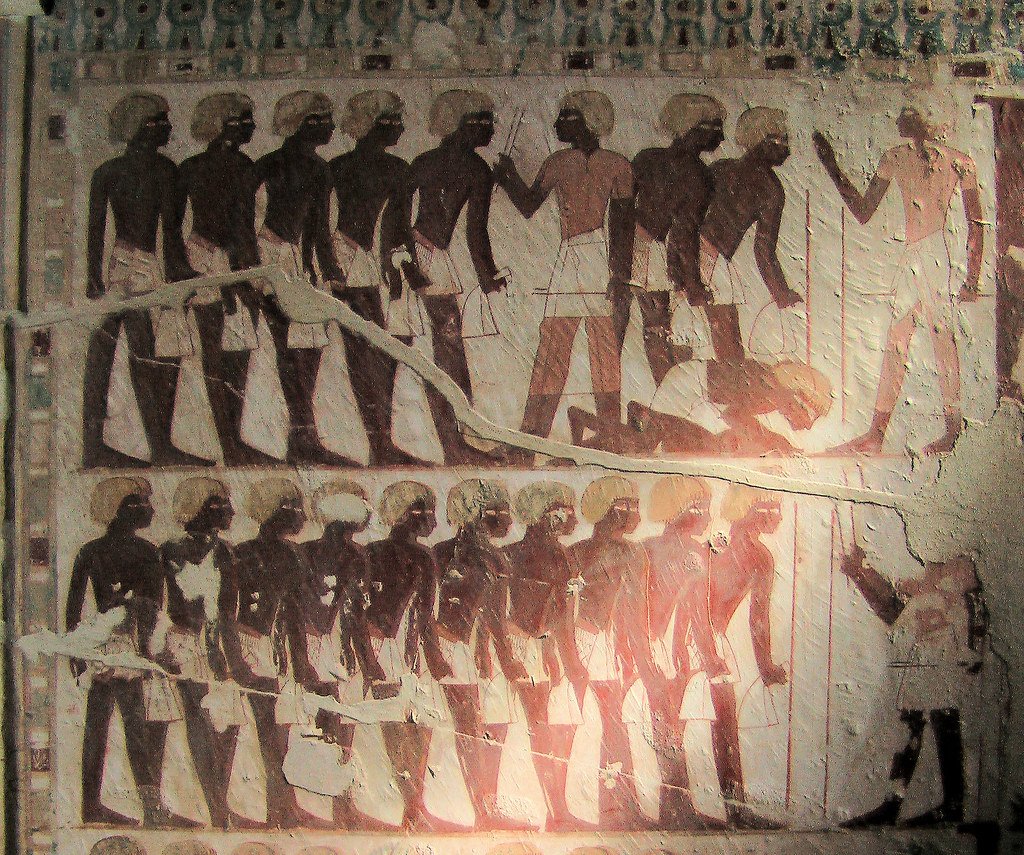so negroid means akon black? lol
Look what "Negroid" means moron. It means broad features and not narrow like narrow noses!
so negroid means akon black? lol
lmaooooooooo! if you wikipedia nubian people thats the pic they usePicked the most Arab admixed ones you could find huh?

i never said lightskinned. militants are saying ancient egyptians looked like lupita not the girl in op
the girl in op looks like she can be family with those people

ok i can agree on the diverse part. but you think there are any women from then that look similar to op?The Ancient Egyptians were a diverse looking people since they were a MIX of different African people. Some were pitch black while others were more brown skinned. Yes some looked like Lupita. Get over it already. I have already posted skeletal evidence and paintings. All of which you ignored or side-stepped. I alreayd showed you paintings showing Egyptians with pitch dark skin like this:
Ancient Egyptians were a mix of broad/narrow featured people.

i never said lightskinned. militants are saying ancient egyptians looked like lupita not the girl in op
the girl in op looks like she can be family with those people
that pigmentationYet the studies I posted said they resembled "Negroids" more than AA's. Your point? Also...


based on?There is no reason to say that someone that looked liked her was not egyptian.
based on?
Yes. Especially during the after the 18th dynasty period. But the Egyptians were not primary lighter toned like you were suggesting, If anything they would have been the same color as someone like Denzel Washington.ok i can agree on the diverse part. but you think there are any women from then that look similar to op?
so that artifact doesnt resemble herOn artifacts that depict a large amount of people with her skin color. But it seems you go blind when any images of that are posted.


Why do African-Americans obsess over Ancient Egypt not over Ashanti, Oyo, Dahomey, Kongo, Mali, Songhai, Sokoto where their ancestors came from?
To dismiss the girl in the op and say she is too light. And lupita is a better example is being militant. But i do agree with you on them varying on skin toneYes. Especially during the after the 18th dynasty period. But the Egyptians were not primary lighter toned like you were suggesting, If anything they would have been the same color as someone like Denzel Washington.
Also it is not "militant" to think that some of the Egyptians would have resembled Nupita. IIRC Nupita is nilotic Luo and the early Egyptians WERE nilotics.
Now does this topic has to do with Ashanti, Oyo, Dahomey, Kongo, Mali, Songhai, Sokoto ???? No. The discussion this about Anicent Egypt. So I don't get how we're "obsessing".Why do African-Americans obsess over Ancient Egypt not over Ashanti, Oyo, Dahomey, Kongo, Mali, Songhai, Sokoto where their ancestors came from?
Lupita would be a possible better example than the woman posted in the OP since the Ancient Egyptians descend from Nilotic cattle raising culture. Heck Nilotic still have some aspects of Egyptian culture:To dismiss the girl in the op and say she is too light. And lupita is a better example is being militant. But i do agree with you on them varying on skin tone
http://wysinger.homestead.com/crown.htmlthe question of the origin of the royal ‘ka’ and the other concerns the origin of the red and white crowns. Wilkinson presents strong evidence that Naqada I was an archetypal representative of the traditional African cattle-culture, a type of society that still exists in a remarkably pure form in the southern Sudan, despite years of civil war. Among Sudanese Nilotes, cattle are raised as symbols of wealth, as the medium for all social transactions (like marriage), and as sources of renewable food (blood and milk). The people rarely kill cattle for meat, which they obtain by hunting wild game. Wilkinson’s overview of the evidence for Naqada I transhumance and cattle burial, coupled with his analysis of the rock art, suggests that Egyptian civilization sprang from a society of broadly similar characteristics. Cows with artificially deformed horns, so common among Nilotes today, are often featured in the early rock art of Egypt and Sudan as well as in Egyptian dynastic art (Kendall 1989, 680–88, fig. 1, 9–12). Even the historic Egyptian symbols of royal office — the crook and the flail — recall a time when the king was seen as the chief herdsman of his people.